Condenser microphones offer better sound quality than dynamic microphones providing a more transparent, detailed, and fuller sound.
Professional vocalists often use this type of mic for live performances because they can capture a performance’s finest details.
In this article, we present to you the best live condenser vocal mics available in the market. Also, we have included a condenser microphone buyer’s guide with some guidelines that you need to know when selecting a condenser mic for live vocal performances.
We also answer some of the frequently asked questions about this type of microphone so that you have a better understanding of them.
Why Use Condenser Mics for Live Performance?
A good quality, well-designed condenser capsule is naturally capable of producing a smooth response through the full frequency range, unlike dynamic mics.
The reason for this is because the capsule of a dynamic and condenser microphones are very different in design and physical characteristics.
The membrane of a dynamic mic is attached to a coil that moves inside a magnet for this reason it needs more sound energy to vibrate and capture the sound.
At higher frequencies, this limitation becomes more evident since higher frequencies have less mass in the sound moving through the air making it more difficult for the membrane to vibrate.
On the other hand, a condenser microphone’s capsule is made from two plates that are separated with a voltage between them. One of the plates is fixed while the other is made from a very thin light material that acts as a diaphragm.
When sound strikes the diaphragm, this vibrates changing the voltage between the plates creating a signal that is later amplified.
Because less sound energy is needed to vibrate the thin plate at higher frequencies, condenser microphones capture clear, crisp highs as well as lows making it very versatile in the full range of frequencies.
Misconceptions About Using Condenser Mics for Live Performance
There are some misconceptions about condenser microphones when it comes to live performances. Many people believe that they have higher handling noise because of their highest sensitivity, but the truth is that condenser microphones have lower handling noise.
Another erroneous idea is that they feedback quicker. Feedback on a microphone has to do with frequency response, speaker and monitor placement and not by the type of microphone being used.
Of course, the polar pattern and response curve play an important role in a microphone quicker feedback but most of the time speaker placement is the main reason.
Here are a couple of detailed articles, one on how to position PA speaker and the other on how to setup stage monitors to get the best sound and avoid feedback.
Best Live Condenser Vocal Mic Reviews
The 10 best live condenser vocal microphones available in the market today are:
- Audio-Technica AT2010
- AKG C5
- Rode M2
- Shure SM86
- Blue enCORE 300
- Audix VX5
- Sennheiser e865
- AKG C7
- Earthworks SR40V
- Neumann KMS 105 MT
Let’s take a closer look at each one to find out their sonic characteristics, features and more.
1. Audio-Technica AT2010 Cardioid Condenser Handheld Microphone
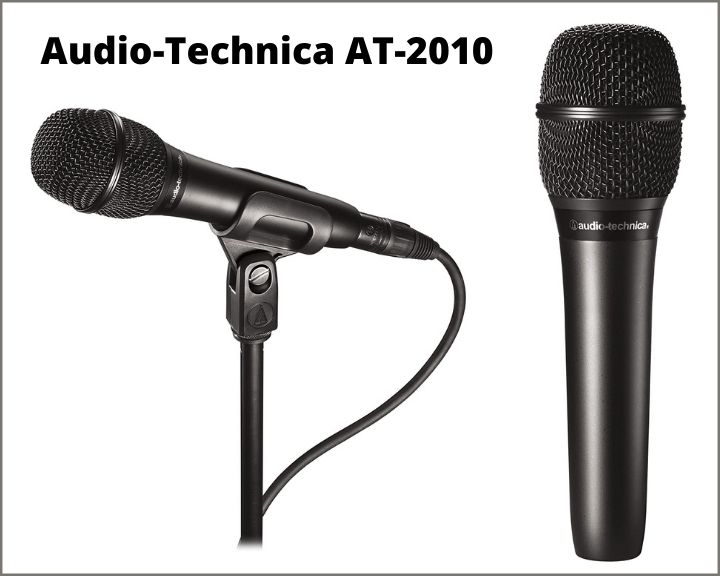
Overview
The Audio-Technica AT2010 is a handheld condenser microphone that offers studio-quality sound in live performances.
Thanks to its 16mm low-mass diaphragm you will get ultra-clear sound that is not possible to get with dynamic mics.
It is designed specifically for close-up vocal use in professional live-sound and studio applications.
Even though this is a budget microphone, vocalists have claimed that when performing using the AT2010 there is nuance and clarity in their voice that helps them to articulate and express better than when using other types of microphones.
The AT2010 microphone requires phantom power to work.
Features
- It uses the same diaphragm found in the critically acclaimed AT2020 side-address studio microphone.
- Extended frequency response and superior transient response that delivers smooth, natural sonic characteristics.
- High SPL-handling and wide dynamic range providing unmatched versatility.
- Cardioid polar pattern reduces pickup from the sides and rear, improving its feedback resistance.
- Multi-stage grille design offers excellent protection against plosives and sibilance without compromising high-frequency clarity.
- Rugged all-metal design and construction for years of trouble-free use in live scenarios.
- Corrosion-resistant contacts from gold-plated XLRM-type connector.
- Includes Quiet-Flex stand clamp that provides silent, flexible microphone positioning.
Specifications
- Microphone Capsule Type: Condenser
- Polar Pattern: Cardioid
- Frequency Response: 40Hz to 20,000Hz
- Impedance: 100 ohms
- Maximum SPL: 136 dB
- Phantom power requirements: 48V DC, 2 mA
- Connector: 3-pin male XLR
- Weight: 8.2 oz. (233g)
Pros
- When it comes to sonic quality, the AT2010 provides a smooth frequency response with beautiful low ends and warm clean sound at mid and high frequencies. It is a very responsive microphone when used as designed for close-up vocal.
- This microphone is ideal for singers with low ranges. Bass singers tend to have low volume in the low registers, in that case by holding the mic closer it would compensate because it is designed to be used for close-up vocals.
- It offers great value for money.
- It does a good job when miking acoustic guitars.
Cons
- Although is a condenser microphone and condensers tend to be very sensitive, the AT2010 is not as sensitive as other condenser mics. This is a disadvantage if the sound source is quiet and is located more than 3 feet away.
- If the performer or vocalist has high sibilance, the mic could sound harsh on the high frequencies.
- It can rumble at high sound pressure levels.
Sound Demonstration of the AT2010
I have personally used this microphone for different purposes and from my experience, I can say that the AT2010 has smooth low and mid-frequency response combined with a crisp and clear high-end that sound good on male and female voices.
Its studio-like sound makes it ideal for live recordings as well as for recording demos in your home recording studio.
Overall, the Audio-Technica AT 2010 is a great microphone that offers great value for the price. It is also ideal for people who are looking for a decent live condenser mic and don’t have the budget for higher-end mics.
RELATED: How to EQ Live Vocals
2. AKG C5 Handheld Condenser Microphone
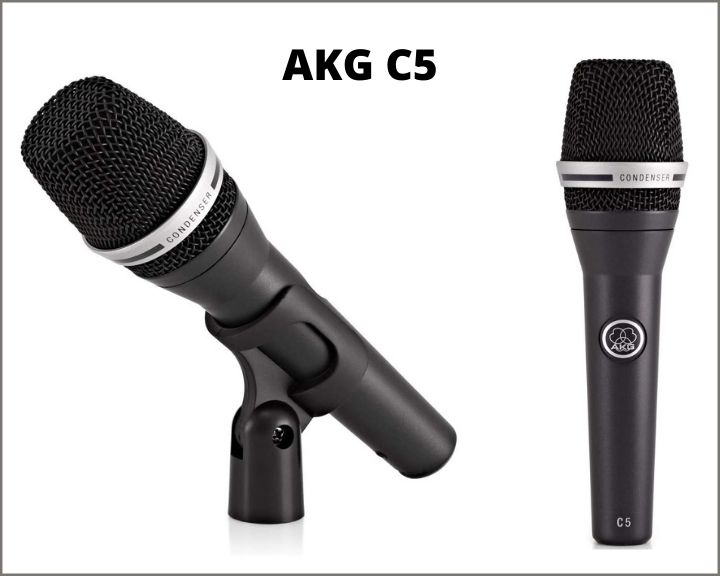
Overview
The AKG C5 is a professional condenser vocal microphone that provides lots of gain before feedback ensuring that your voice will cut through the loudest mix on any stage.
That’s thanks to its cardioid polar pattern. It has been optimized to be used with in-ear monitor systems.
This microphone comes with an attachable presence boost adapter offering the unique choice of two sound flavors for a superior audio performance.
The transducer case is gold-plated protecting the capsule from corrosion and humidity. With its extremely rugged grille construction and solid die-cast housing the AKG C5 is a reliable companion for tough stage jobs.
Mainly designed for lead and backing vocals applications you will be sure to love the clear sound that this microphone can produce.
As all condenser microphones, the AKG C5 requires phantom power to work.
Features
- The condenser capsule has been specifically tailored for a detailed pickup of unique individual acoustic color.
- 24-carat gold-plated transducer case for maximum resistance to corrosion and humidity.
- It comes with an attachable unique presence boost adapter model PB 1000 that naturally boosts frequencies by 5dB between 5kHZ and 9kHz giving you a choice of two different sound flavors, also improving vocal intelligibility.
- Integrated shock absorber system effectively eliminates unwanted handling noises
- Rugged condenser microphone for vocal miking on stage.
- Extremely resilient, spring-steel wire-mesh cap for extra impact resistance.
- Built-in windscreen/pop filter for effective suppression of pop and breath noise.
- The transducer shock mount reduces handling and cable noise.
- The cardioid polar pattern is Frequency-independent for high gain before feedback.
- The microphone housing is very robust made of zinc-alloy combined with the extremely resilient spring steel grille, makes the C5 a rugged mic choice for a long stage life.
Specifications
- Microphone Capsule Type: Condenser
- Polar Pattern: Cardioid
- Frequency Response: 65Hz to 20,000Hz
- Impedance: 200 ohms
- Maximum SPL: 140 dB
- Phantom power requirements: +48VDC, 3 mA
- Connector: 3-pin male XLR
- Weight: 12.2 oz. (345g)
Pros
- The AKG C5 has been highly rated for providing a low range punch with clear mids and highs, emphasizing on the lows, ideal for singers that want a strong male vocal presence, or female vocalists that want more presence on their sound. With this mic your voice will sound bigger and mellower the closer you hold the microphone to your lips.
- A good sonic characteristic about the C5 is how the sound can change by modifying your working distance. Moving away from the microphone will produce a more reverberant, more distant sound as the microphone will pick more of the room’s reverberation.
- Moving the mic closer to your mouth, less than 2 inches will give more body to your voice and an intimate, bass-heavy sound.
- Sing to one side of the microphone or above and across of the mic’s top provides a well-balanced, natural sound.
- You can use this effect to make your voice sound aggressive, neutral, insinuating, etc. simply by changing your working distance.
Cons
- Some users have reported that if singing directly into the microphone, it can pick up excessive breath noise. Also, if a voice is to sibilant it can overemphasize “sss”, “sh”, “tch”, “p”, and “t” sounds.
- The microphone is very insensitive to off-axis sounds, meaning that if two vocalists were to sing into the microphone from an angle wider than 35 degrees, you may end up with a feedback problem.
For vocalists that are looking for a good quality live condenser microphone that is rugged on live stages yet provides clear, crisp sound, I recommend this mic.
It is also a good choice for live or home studio recordings to lay down demos with excellent results.
At this price range, the AKG C5 is an impressive microphone that makes it hard to find a better competitor. It is a mic that provides good features with a great balance between sound quality and ruggedness.
If you are looking for a good quality live condenser microphone at an affordable price, this is a great choice.
3. Rode M2 Handheld Condenser Microphone
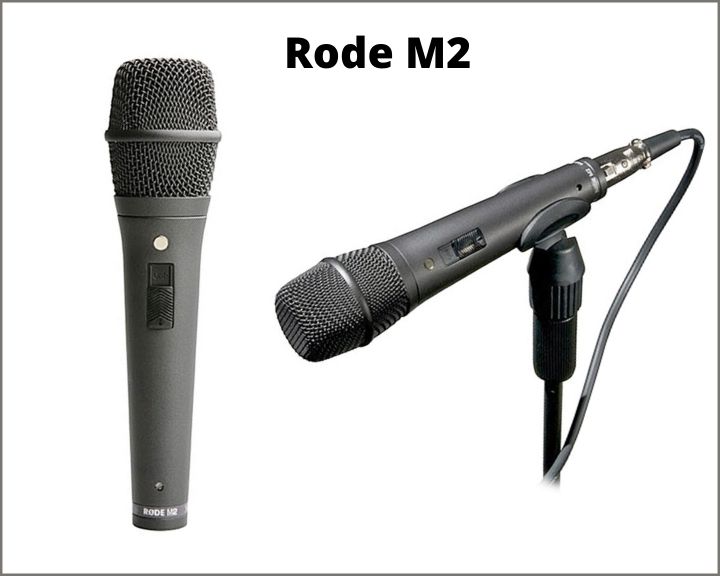
Overview
The Rode M2 is a rugged handheld condenser microphone that is designed for live performances. It provides a full frequency response with a tailored-for-stage super-cardioid polar pattern that ensures less feedback at higher volumes.
The 1/2” condenser capsule is shock-mounted so that it reduces the handling noise to a minimum. The M2 is designed to offer the ruggedness and reputation of a dynamic microphone but with the sonic quality of a studio condenser mic.
The Rode M2 condenser microphone requires phantom power to work.
Features
- Small diaphragm 1/2” condenser capsule.
- Sonically tailored condenser vocal microphone for live stages.
- Feedback rejecting super-cardioid pick up pattern.
- It has an on/off switch that is lockable so that the switch can’t be moved by mistake.
- It is ergonomically designed to fit your hand comfortably.
- The body of the microphone is made of heavy-duty metal.
- Offers a high level of RF rejection
- Low handling noise.
- 10-year extended warranty when you register your microphone on Rode’s website.
- It is designed and manufactured in Australia at Rode’s manufacturing facility ensuring high-quality controls from design to manufacturing.
- It includes a zip pouch and stand mount with 3/8″ thread adapter included.
Specifications
- Microphone Capsule Type: Condenser
- Polar Pattern: super-cardioid
- Frequency Response: 25Hz to 20,000Hz
- Impedance: 50 ohms
- Maximum SPL: 141 dB
- Phantom power requirements: +48VDC, 3 mA
- Connector: 3-pin male XLR
- Weight: 10.9 oz. (308g)
Pros
- One of the things that stand out about the Rode M2 mic is how flat is its frequency response curve between 100Hz to 9kHz. The higher frequencies between 10kHz and 16kHz have a gain of only 3dB. What this translates to is a more natural sound that is not excessive in the high frequencies delivering a warmer sound with sonic characteristics similar to some of the modern ribbon microphones.
- If you have a nasal voice, raspy voice or boomy voice you could benefit from a mic with a flat frequency response curve like the M2 because the mic can flatten out the unwanted peaks of your voice producing a more natural sound.
- The super-cardioid polar pattern in the M2 has a narrower pickup angle in the front providing more rejection to ambient sound. To be more specific, it has a 120-degree coverage angle, thus significantly reducing feedback
Cons
- Some singers have reported that due to its flat response depending on the range of your voice it needs significant equalization to cut through the mix.
Rode M2 Sound Demo
Singers and presenters can benefit from the RODE M2 flat frequency response in live stages because it delivers a more natural sonic tone, as well as low feedback thanks to its narrower polar pattern.
Its price is reasonable, and this is one of the best live condenser vocal mics you can lay your hands on at this price range.
It can also be used to record your live presentations as well as for home recordings. This would make a great addition to your mic arsenal or as a first condenser microphone for vocalist.
4. Shure SM86 Handheld Condenser Microphone
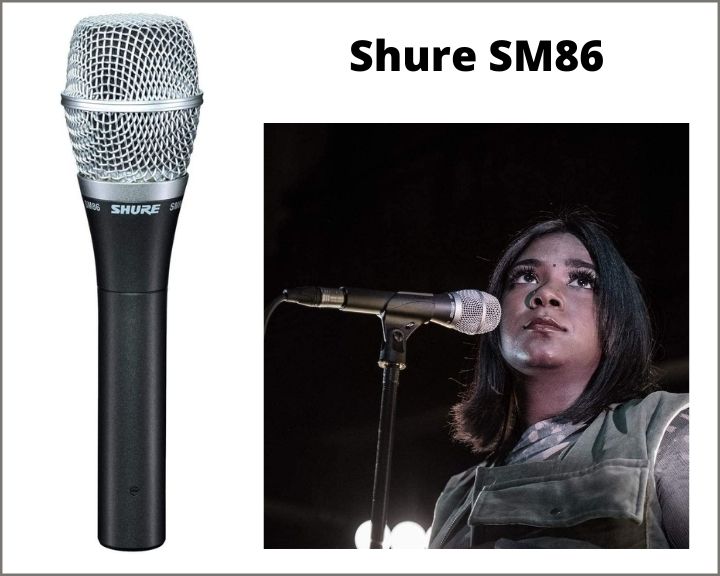
Overview
The 2003 TEC award winner SHURE SM86 is a unidirectional, cardioid condenser microphone that brings studio-quality sound to the stage. It was designed as an extremely rugged touring mic as all the microphones in the SM line.
Its frequency response is tailored specifically for lead vocals consistently delivering great transients, balanced frequency response and wide dynamic range that translate in crisp, smooth reproduction of vocals.
This microphone is constructed with a three-point shock mount to effectively reduce handling noise, and a two-stage internal pop filter decreasing to a minimum excessive breath noise and voice sibilance.
Features
- The electret condenser capsule delivers studio-quality sound in live stages.
- Tailored frequency response for clear reproduction of vocals.
- Rugged construction withstands the rigors of touring sound.
- Thanks to its cardioid polar pattern minimizes unwanted background noise making it ideal to works well with both stage monitors and in-ear personal monitors.
- With its built-in three-point shock mount handling noise, it’s minimized.
- Two-stage pop filter reduces wind and breath noise.
- Includes storage pouch and stand clip.
- Requires +48VDC phantom power.
Specifications
- Microphone Capsule Type: Electret Condenser
- Polar Pattern: cardioid
- Frequency Response: 50Hz to 18,000Hz
- Impedance: 150 ohms
- Maximum SPL: 147 dB
- Phantom power requirements: +48VDC, 5.2 mA
- Connector: 3-pin male XLR
- Weight: 9.8 oz. (278g)
Pros
- One of the sonic characteristics of the Shure SM86 is that it has a low-frequency roll-off between 50Hz and 150Hz to counteract the proximity effect when the mic is used too close to the mouth.
- Between 2kHz and 5kHz some of the mid frequencies are boosted to provide clear vocal presence with a maximum peak of 7dB at 9kHz. Thanks to the subtle boost in the mid frequencies it delivers a sound that is warm and thick. Most condenser mics can deliver crisp sound in the higher frequencies, but the mix ends up sounding thin. The SM86 has a balance between mid and high frequencies.
- Some users have reported that it is an excellent microphone to be used for home recordings. While it is designed and tailored for vocals it has been used to mic guitars, drums and other acoustic instruments with excellent results.
Cons
- Some performers have mentioned that this microphone is better to be used indoors and not outdoors because it can pickup the noise of wind very easily if used in a windy place.
SM86 Sound Demonstration
The Shure SM86 is the condenser version of the industry-standard SM58 providing good sonic quality that delivers thick, warm clear vocals with enough punch for lower range voices without sounding harsh at higher frequencies.
It is also a great choice for female voices thanks to its mid frequencies boost delivering a sound that has enough presence to easily cut through the mix without sounding thin.
This is a great choice for churches because this microphone can be used for the worship band as well as for the spoken word and presenters in general.
If your worship services are recorded or transmitted live on the internet, with this mic you can be assured that your audience will hear a studio-quality sound.
For these and many more reasons this is one of the best live condenser vocal mics in the market today.
5. Blue enCORE 300
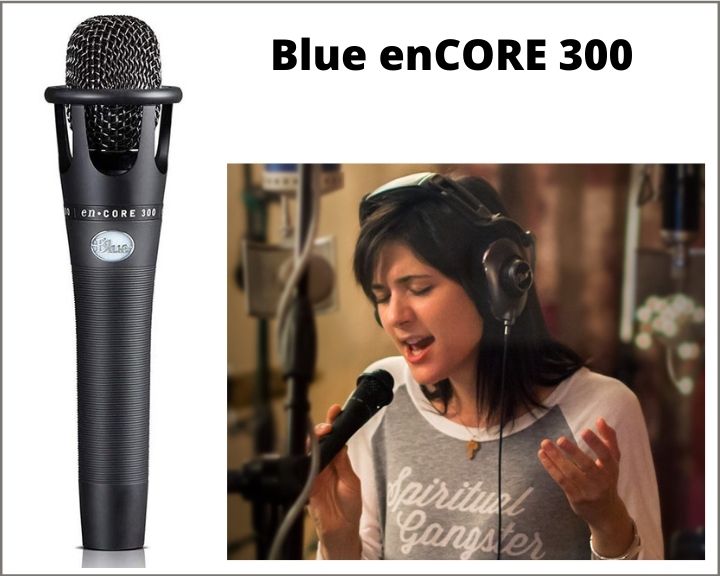
Overview
The encore 300 provides you with excellent sensitivity and limited feedback problems when used on stage. This is hard to come by when choosing a microphone to be used in live environments.
When it comes to clarity, this mic cuts through the mix, bringing new life to live vocals. When comparing it to other condenser microphones in the $200 range, it delivers excellent sound, and it will easily become your go-to mic.
Each microphone will react differently depending on the room’s acoustics, cabling, preamp setup, etc. But one thing you can be sure of is that the vocal range of the enCORE 300 is spot-on.
It provides a relatively flat frequency response from 200 Hz to 5 kHz, which falls within the vocal range, making it easier for the sound engineer to fine-tune the EQ to deliver a fantastic performance.
Features
- It offers a cardioid polar pattern for maximum feedback rejection
- Premium condenser capsule hand-tuned for vocals
- The chassis is designed to maximize airflow to deliver a smooth and open sound while protecting the capsule.
- It offers a unique design that will stand out from other microphones.
- It comes bundled with a soft-grip microphone clip and a soft-lined storage pouch
- The condenser capsule is isolated from the chassis using Blue’s proprietary floating mount
- You can be sure that this mic will last, thanks to its heavy-duty metal construction.
Specifications
- Capsule Type: Condenser
- Polar Pattern: Cardioid
- Its frequency response is from 40Hz — 20kHz
- Requires Phantom Power
- The maximum Sound Pressure Level (SPL) is 146dB
- Output Impedance: 25 ohms
- Sensitivity: 11mV/PA
- Weight: 0.38 kg (0.84 lbs.)
Pros
- The enCORE 300 delivers exceptional details and dynamics.
- With this mic, it’s easy to get a clear voice as it doesn’t need too much EQ to fine-tune it
- Its top-end response is smooth, delivering enough brightness without being harsh
- The mid frequencies are relatively flat, and the lows are warm without being heavy or boomy
- This mic works well on a broad range of voices, whether it is being used by a male or female performer
Cons
- It can have some handling noise when compared to other mics in the same price range
- This microphone is a bit on the heavy side which is not a good thing, especially if you need to hold it for hours.
Keep in mind that condenser mics, in general, are more sensitive, and they can pick the most subtle nuances in vocals. What this means is that they are not as forgiving as dynamic mics.
The enCORE 300 and all mics presented in this post will pick any flaw in the performance in detail.
6. Audix VX5 Condenser Microphone, Super-Cardioid
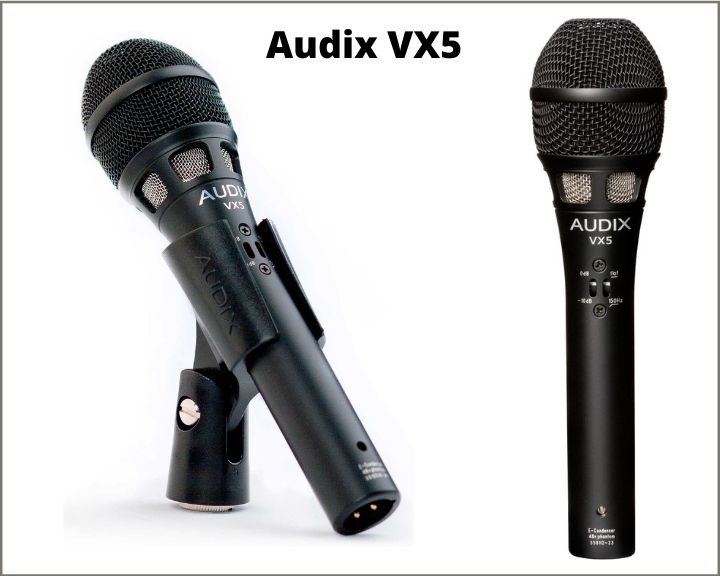
Overview
The Audix VX5 is a professional handheld unidirectional super-cardioid condenser microphone that is designed to be used in a wide variety of live, studio and broadcast applications.
With its smooth and accurate frequency response, this microphone is known to bring studio-quality sound to your live performance.
It is very resistant to feedback and with its 14mm small-diaphragm capsule it has the ability to handle very high sound pressure levels without distorting the sound.
Thanks to its tailored frequency response curve and high sound pressure level it can pick up the nuances of a good singer as well as handle the strong voice of a powerful singer without sounding distorted or harsh. Highly recommended for female vocals.
The VX5 is manufactured with a precision die-cast zinc alloy body, durable black electrostatic coating finish that ensures years of use even in the most demanding live stages.
Features
- Premium electret condenser capsule specially designed for use in vocals and acoustic instruments
- Smooth accurate frequency response with selectable switch for a flat response or bass roll-off.
- Selectable -10 dB or 0 dB pad (pad is an attenuator switch to decrease excessive signal coming from the microphone)
- Suited for acoustic music as well as loud stages
- Acoustically ported steel mesh screen
- 14mm gold vapor diaphragm
- Rugged die-cast zinc body
- Black satin finish
- Requires +48V phantom power
- Designed, assembled & tested in the USA
- 3-year warranty
Specifications
- Microphone Capsule Type: Pre-polarized Electret Condenser
- Polar Pattern: super-cardioid
- Frequency Response: 40 Hz to 16,500 Hz
- Impedance: 150 ohms
- Maximum SPL: 140 dB
- Phantom power requirements: +48 VDC, 3.5 mA
- Connector: 3-pin male XLR
- Weight: 8 oz. (277g)
Pros
- One feature that stands out about this mic is the ability to select between a flat response or bass roll-off. If the flat response is selected, you will get a relative horizontal frequency response between 200Hz and 2kHz. This could help people with voices that are nasal, raspy or boomy to flatten out their sound before equalization so that a more natural EQ could be performed on their voice to give it more presence.
- With the flat response switch selected the microphone can deliver detailed, ribbon-like natural vintage sound but with crisp and clear highs.
- Also, by having the flat response switch selected makes the microphone more versatile because it can be used to capture acoustic instruments such as guitar, woodwinds, brass, percussion toys, drum overheads, hi-hat, and piano.
- By selecting the bass roll-off, there will be a 10dB decrease on the frequency response between 50Hz and 500Hz which would help to counteract the proximity effect of the microphone. Just to clarify, proximity effect is an increase in the volume of bass frequencies as source sound gets close to the microphone.
Cons
- It is not as rugged as the Shure Beta 87A or the SM86.
- The pickup capsule is highly sensitive and needs to avoid extreme temperatures and moisture because it can adversely affect the sound performance.
This is one of the best live condenser vocal mic available in the market under $300. It is one of the best sounding mics that is tailored for both vocals and acoustic instruments.
It is very versatile and offers you a lot of gain before feedback thanks to its super-cardioid pattern.
The VX5 can effectively be used in studios as well as in live stages delivering crystal clear sound emphasizing on vocal nuances for experienced singers as well as capturing distortion-free performances from very loud singers.
7. Sennheiser e865 Lead Vocal Condenser Microphone
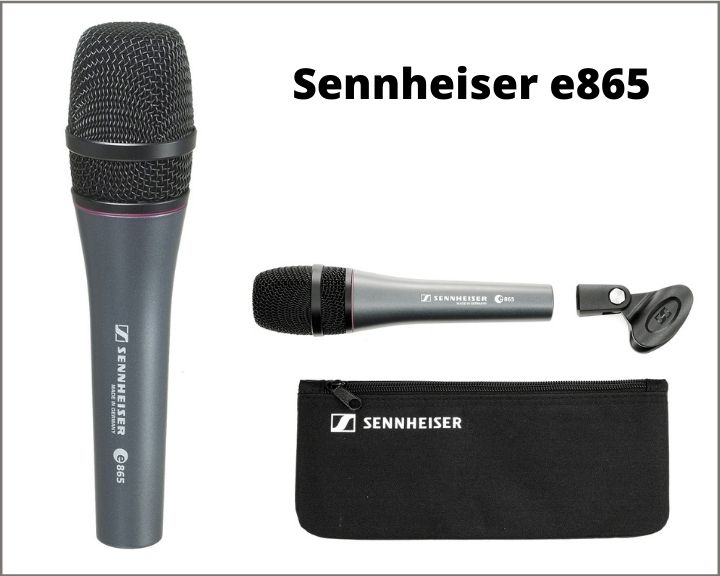
Overview
Widely acclaimed for being sensitive to every nuance and tough on the road the SENNHEISER E865 is a professional super-cardioid condenser vocal microphone utilizing the best in condenser microphone technology to achieve high sound quality.
No matter whether it’s quiet or loud, far away or right up close: the e865 makes every sound silky smooth and warm.
The highly sensitive membrane picks up the finest vocal nuances and conveys even extreme dynamics into the signal chain with ease.
Even when the lips at some distance from the capsule, the e865 delivers consistent sound quality. It combines the professional qualities of the condenser capsule with the rugged design of the 800 series.
On the one hand, It works perfectly good for presenters and speakers that allows precise reproduction, even of plosive sounds.
Features
- High-quality condenser capsule tailored for speech and vocals.
- Supercardioid polar pattern for excellent feedback rejection.
- Natural reproduction with emphasized presence.
- Consistent sound quality (varying distances, moving off-axis).
- Distortion-free reproduction even at very high sound pressure levels.
- Optional silent on/off switch (only available on the S-version e865s)
- Low sensitivity to handling noise.
- Rugged metal housing
- Includes carrying pouch and microphone clip.
Specifications
- Microphone Capsule Type: Pre-polarized Electret Condenser
- Polar Pattern: super-cardioid
- Frequency Response: 40 Hz to 20,000 Hz
- Impedance: 200 ohms (Balanced)
- Maximum SPL: 150 dB
- Phantom power requirements: +48 VDC 3.5 mA
- Connector: 3-pin male XLR
- Weight: 11 oz. (311g)
Pros
- This microphone can deliver a crystal-clear silky-smooth tone for both male and female performers. The feedback rejection is great thanks to its super-cardioid polar pattern. Especially good for churches and houses of worship where high definition sound plays an important role in the service.
- Presenters and speakers will also benefit from this microphone thanks to its vocal tailored frequency response.
- The e865 microphone can deliver a warm smooth sound for your podcasts or video productions.
- Your voice is too loud when singing or speaking! No problem, this microphone will deliver distortion-free sound even on the loudest sound sources such as a vocalist of a metal band or a rapper.
Cons
- This microphone is not tailored to be used in acoustic instruments so basically this is not a universal mic that can be used for different purposes. It is designed to be used for vocalists, backup singers, presenters or speakers.
Vocalists can be assured that this microphone is considered as one of the best live condenser vocal mics on the market in the mid-range price.
It delivers a great crisp sound and is constructed to last a long time in even in most demanding performing stages.
At our church, there are two of these microphones and they still deliver great sound after 6 years of use.
If you are a singer, presenter, preacher, or podcast creator and are looking to buy a great handheld condenser mic, give the e865 a try, you will not regret it.
8. AKG C7 Handheld Condenser Microphone
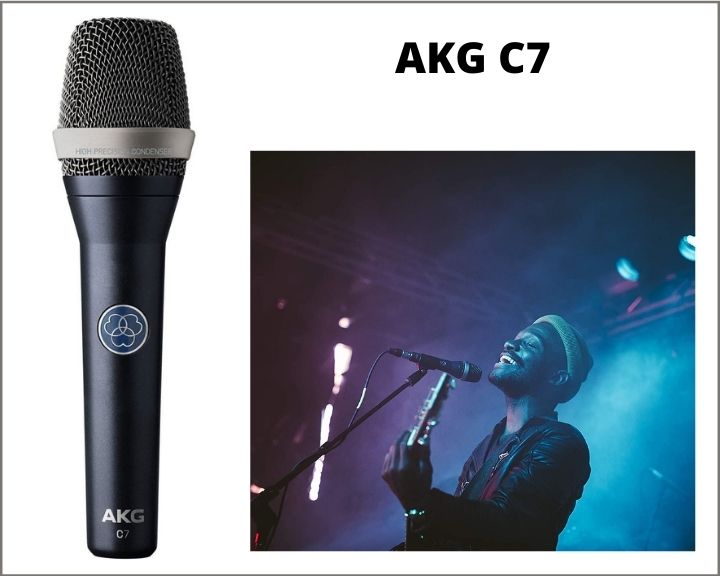
Overview
World-renowned microphone manufacturer AKG produces some of the best mics in the market.
Such is the case of the AKG C7 a professional handheld microphone featuring a custom-tuned super-cardioid condenser capsule that is manufactured and assembled using hand-selected components, so your voice is reproduced with natural clarity and accurate highs.
AKG has taken a different approach to reduce feedback, and to do so they have designed an innovative open-space capsule, that uses a specially designed inner-capsule holder and three window ports to reduce air turbulence and reflections at the backside of the capsule.
This creates an extremely consistent super-cardioid polar pattern throughout the entire frequency spectrum, for extraordinary feedback and spill rejection.
Extensive research was done to find the right material that has strong absorption properties to isolate the capsule from the mic’s housing. The result is a proprietary mechano-pneumatic shock absorber suspension that ensures the lowest possible handling noise.
The capsule sits on top of a unique rubber insert, preventing vibrations from the housing from reaching the capsule.
Features
- 3/4” medium size custom-tuned condenser capsule that delivers studio-quality sound in a handheld mic.
- AKG proprietary open-space capsule design providing impressive gain before feedback.
- Proprietary mechano-pneumatic shock absorber suspension to protect against handling noise.
- Multilayer pop noise protection keeps plosives at the lowest levels.
- Rugged full metal body constructed of zinc alloy with spring steel grille to ensure long life of use.
- 24-Karat gold-plated capsule for maximum resistance to corrosion and humidity.
Specifications
- Microphone Capsule Type: Pre-polarized Electret Condenser
- Polar Pattern: super-cardioid
- Frequency Response: 20 Hz to 20,000 Hz
- Impedance: 600 ohms (Balanced)
- Maximum SPL: 150 dB
- Phantom power requirements: +48 VDC 3.5 mA
- Connector: 3-pin male XLR
- Weight: 11.2 oz. (317g)
Pros
- The AKG C7 has been designed to deliver precise sound. The high frequencies never sound harsh or too bright, the mid frequencies capture a warm sound and the bass doesn’t sound boomy.
- The frequency response curve clearly shows a flat response between 200Hz and 2000Hz with a slight increase between 2500Hz and 5000Hz. At 10kHz there is a gain of 6dB. From there the frequency rolls off towards 20Khz.
- What this means in terms of sound is that with the C7 your voice is captured and sent to the mixing board or interface very natural and precise. It needs very little equalization which translates to more real and natural performance.
- Some microphones exaggerate the highs or are too strong in the lows, this is not the case with the C7, it is very consistent through the full range. Highly recommended for people with soft voices where nuance is required.
- Thanks to its high sound pressure levels it can be used for singer with strong voices as well such as sopranos, tenors, or baritones, but the singer should be aware that when singing they should change the distance between the mouth and microphone so that the dynamics of your voice is not affected by the proximity effect.
Cons
- Might not suit every vocalist, if you don’t like flat sound you might want to consider something else. But keep in mind that if you get a flat response from a microphone it is possible to adjust it with EQ.
The AKG C7 is hailed by many singers as one of the best live condenser vocal mic available in the market, it has many good features and you can be assured that the rugged build quality will withstand the abuse of live stages.
The sonic characteristics will meet or exceed your expectations thanks to its very carful design taking into consideration many factors.
9. Earthworks SR40V
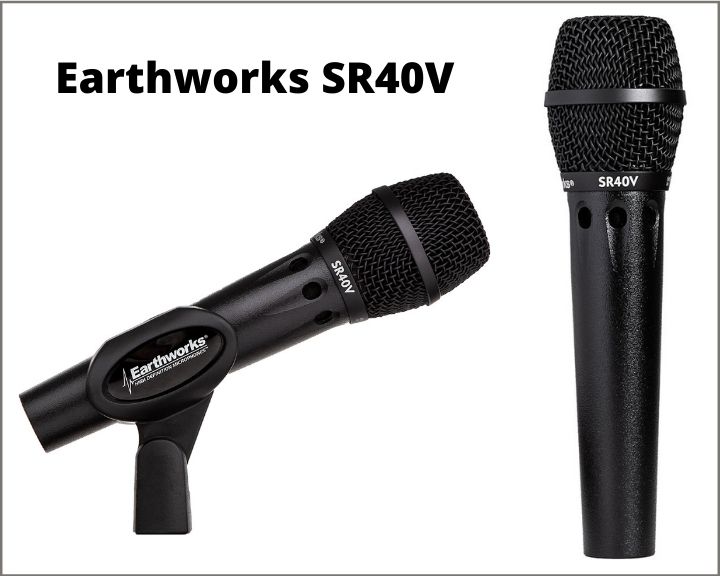
Overview
Getting a consistent vocal sound in any venue is not an easy task because many factors can affect the performance. The same EQ that works perfectly well in one venue could be a nightmare on the next.
One thing that helps to get consistent sound is using a microphone that doesn’t add coloration to whatever is placed in front of it.
You want a mic that is as flat as it can be so that you decide the coloration and EQ depending on the venue where you are performing.
Of course, the EQ will be different each time, but you can fine-tune the equalization until your sound is consistent by starting with a flat response.
The Earthworks SR40V provides you with just that. Its frequency response is so flat that it is almost unbelievable. From 100 Hz to 20 kHz, it is as neutral as it can be, enabling you to EQ your vocals to precisely what you want.
Features
- It offers an almost perfect hypercardioid polar pattern that is very consistent, which helps to avoid feedback problems on stage
- The SR40V is phase and time coherent, meaning that the source’s sound and the signal coming out of the mic are identical waveforms with no time discrepancies. This makes it ideal for performers that use in-ear monitoring systems
- It delivers lightning-speed transient response making it a high-speed microphone. In case you don’t know, the transient response is how fast a microphone diaphragm responds to fast peaks in sound. The Earthwork SR40V delivers the fastest transient response of any vocal mic available in the market today
- Thanks to its flat response, the front of house engineer has a clean canvas to add the necessary sound coloring and deliver a spotless EQ depending on the voice that’s put in front of it
- Works great for female singers and males with tenor voices. Because condenser mics are usually boosted on the higher frequencies to provide clarity, the end result can be a harsh sound if you have a bright voice. The SR40V doesn’t boost the high-end frequencies, making it the perfect choice for voices that tend to be excessive on the higher end frequencies
- The chassis is made from stainless steel to ensure long life operation
- It comes bundled with a microphone clip and a protective fabric bag
- Each capsule and output circuitry are handcrafted and matched to deliver high-definition detail and optimum performance
Specifications
- Frequency Response: 20Hz – 40kHz
- Polar Pattern: Cardioid
- Sensitivity: 10mV/Pa (-40dBV/Pa)
- Requires Phantom Power
- Maximum input Sound Pressure Level (SPL): 145dB
- Output connector: XLR-3M
- Minimum Output Load 600Ω, balanced between pins 2 & 3
- Dimensions Length: 7.25 in. (184mm), Max dia: 1.95 in. (55.3mm), Min dia: .97 in. (27.5mm)
- Weight: 0.80lb (363g)
Pros
- It picks EXACTLY what it’s put in front of it
- Works great for recording as well
- Thanks to its polar pattern, it does pick surrounding sounds, making it perfect for live environments
- It was designed for vocals delivering an excellent response.
- People with bright voices will sound beautifully with this microphone because it doesn’t boost the high-end frequencies by nature.
- Made in the USA with high-quality standards
Cons
- It’s a bit pricey, but if you want high quality live vocals, you need to spend the money
Earthworks SR40V Sound Demostration
With the Earthworks SR40V, you will get studio-like quality sound in live performances, making your audience appreciate the performance’s nuances and crisp detail.
10. Neumann KMS 105 MT Condenser Microphone.
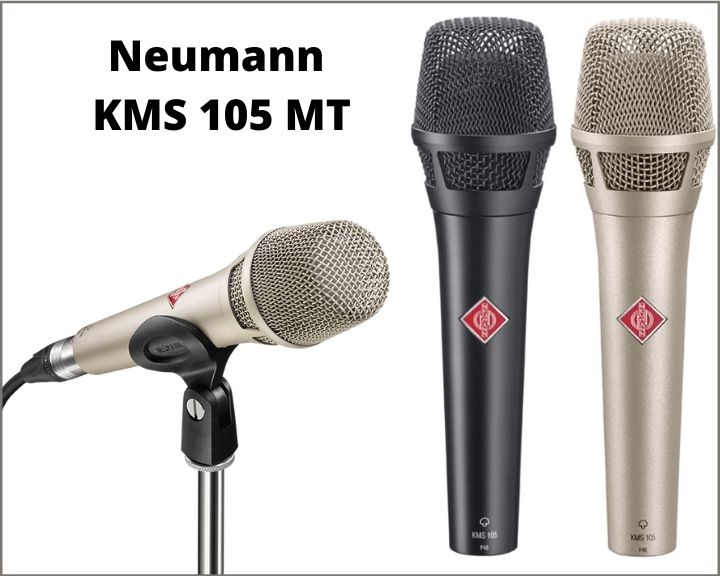
Overview
The Neumann KMS 105 is at the top of our list as the best professional live condenser vocal mic. It delivers Neumann studio sound quality on a live stage.
It is equipped with top of the line electronic components starting with its precision manufactured condenser capsule using only the best of materials. It has a slick luxurious look and is lightweight.
The microphone is very rugged built to withstand live stages. It has a thick-walled metal housing that protects the internal circuitry and a head grille made of hardened steel that features a carefully designed multi-level pop filter made of wire gauze.
Unlike regular microphones that use foam as a pop filter causing vocals to sound opaque and foggy, the KMS 105 acoustic filter doesn’t cause any sibilance problems or compromise the capsule’s directivity.
The impedance matching on this microphone is done electronically, making it transformerless, reducing electromagnetic interference, thus eliminating hum noises.
Thanks to its very low output impedance if you need a long cable run up to 1000 ft (300 m) there will be no transmission losses.
Features
- Precision condenser capsule for crystal clear vocal sound.
- Transformerless output for less electromagnetic interference and hum noise.
- Very low impedance for long cable runs without loss.
- Neumann studio-quality sound for vocals or speech on a live stage.
- Without off-axis coloration
- Supercardioid polar pattern for exceptional feedback rejection and off-axis coloration
- Effective pop shielding without losing sound quality
- Includes nylon carrying bag and stand mount.
- Requires +48V phantom power
- Capable of handling extreme sound pressure levels
- Rugged construction
- Built-in pop screen
- Very low handling noise
Specifications
- Microphone Capsule Type: Pre-polarized Electret Condenser
- Polar Pattern: super-cardioid
- Frequency Response: 20 Hz to 20,000 Hz
- Impedance: 50 ohms (Balanced)
- Maximum SPL: 150 dB
- Phantom power requirements: +48 VDC 3.5 mA
- Connector: 3-pin male XLR
- Weight: 10.6 oz. (300g)
Pros
- When it comes to the sound characteristics of the Neumann KSM 105 it has a low-frequency roll-off starting at 200 Hz and decreasing towards 0 dB at 50 Hz. What this means in simple English is that this microphone decreases the bass sound if you sing close to it resulting in a clean
- It has an extremely flat response from 200 Hz to 2 kHz and a delicate increase of less than 2 dB between 2kHz and 5Khz producing natural sound capturing the nuance in the performance.
- Thanks to its sensitive diaphragm it can capture a vastly superior transient response resulting in a more immediate, more emotional vocal sound.
- Just to clarify, the transient response of a microphone is how fast can the membrane or diaphragm responds to a high peak of sound in a short duration. An easy example of a high-level peak sound could be a hand-clap. A condenser microphone has a very fast transient response, unlike dynamic microphones that have a heavier membrane which slows down its response.
- Out of many reviews, 98% give it 5/5 stars from professional to beginner singers. Ideal to be used for soloist in bands, churches, houses of worship, etc.
- The KMS 105 is designed to be used as a vocal microphone but thanks to its frequency response, wide dynamic range, and high sound pressure level it can be used for other stage applications such as percussion, saxophone, trumpet, trombone, harmonica, acoustic guitar, and guitar cabinets.
- Its superior sound quality makes this microphone also a great choice for home recording studios and broadcast applications. Thanks to its optimized close mic placement and low proximity effect, the KMS 105 will pick up a dry sound with very little ambiance, which is a big advantage in untreated rooms.
Cons
- Very few people have reported that depending on the stage it could feedback easily. This can be argued because monitor placement plays an important role in the microphone’s feedback.
- The price tag is high, some users have argued that there could be a cheaper mic with the same sonic characteristics.
Neumann KSM 105 Sound Demonstration
The Neumann KSM 105 is the best professional live condenser vocal mic delivering studio-quality sound in live stages.
Thanks to its frequency response, dynamic range and high SPL this mic can be also used for miking many acoustic instruments with excellent results.
If the price tag is within your budget, I highly recommend this microphone for a female or male vocalist who wants a clear, crisp, uncolored sound that is very sensitive to vocal nuance as well as very responsive transients.
Best Live Condenser Vocal Microphone – Buyer’s Guide
When selecting a condenser mic for live performances there are few aspects that need to be taken into consideration, these aspects are polar pattern, frequency response and response curve, maximum sound pressure level or SPL.
Let’s take a closer look at each one of them.
Polar Pattern
The polar pattern of a microphone is basically a representation of how well a mic can pick up the sound coming at it from different directions. This is also called directionality.
We are used to seeing polar patterns in brochures and manuals as two-dimensional characteristics, but they are three-dimensional.
There are 7 polar patterns: omnidirectional, cardioid, subcardioid, super-cardioid, hyper-cardioid, bi-directional, and shotgun.
Which one would be the best polar pattern for live condenser vocal microphones? let’s look at each one of them to answer this question.
Omnidirectional
This type of microphone can pickup sound from all directions having equal sensitivity at every angle. It has a 360-degree coverage angle and 100% ambient sound sensitivity.
This is disadvantageous in live stages since they are easier to feedback because the microphone can’t be aimed away from loudspeakers.
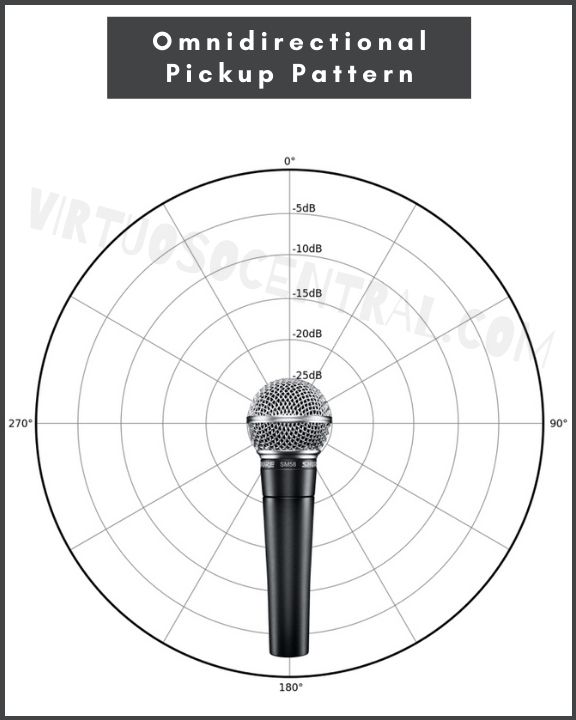
Cardioid
Microphones with this pattern are most sensitive in front and less sensitive in the back making it ideal for live stages where there is some noise in the background.
It has a 131-degree coverage angle and 33% ambient sound sensitivity. They are less prone to feedback due to these characteristics. This type of pattern is the most common in live stages.
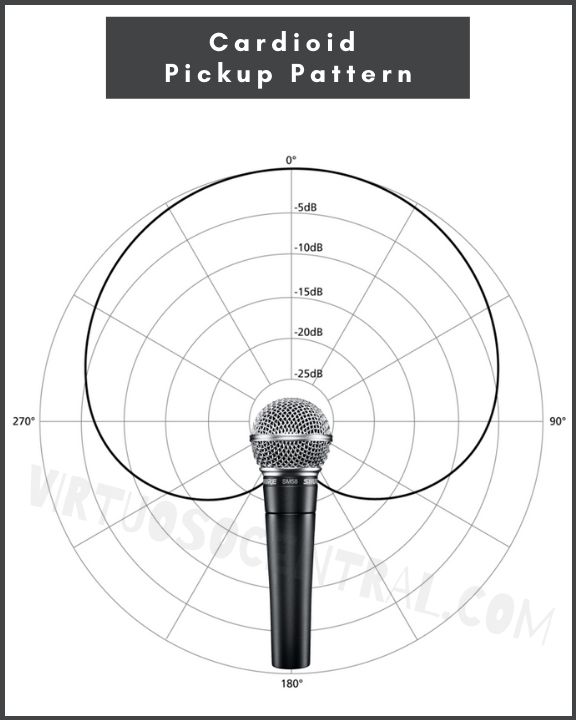
Subcardioid
This pattern has a wider coverage angle and a higher percentage of ambient sound sensitivity, basically falling in between omnidirectional and cardioid polar patterns.
For these characteristics, microphones with this polar pattern don’t perform well in live situations, especially if using condenser capsules.
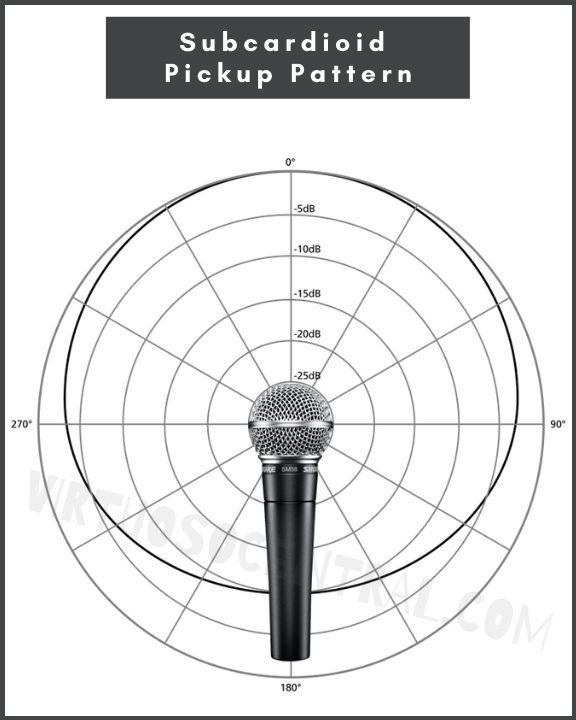
Supercardioid
A microphone with this polar pattern has a narrower pickup angle in the front providing more rejection to ambient sound.
To be more specific, it has a 115-degree coverage angle and 27% ambient sound sensitivity. These characteristics make it ideal for a live condenser vocal microphone.
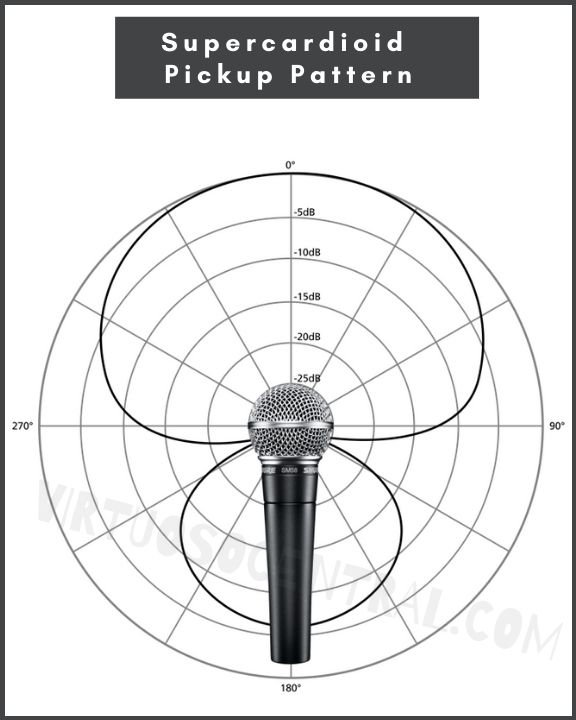
Hypercardioid
This pattern has a narrower pickup angle than super-cardioid rejecting more ambient sound and reducing feedback. It has a 105-degree coverage angle and 25% ambient sound sensitivity.
These polar characteristics make it also ideal for live condenser vocal microphone.
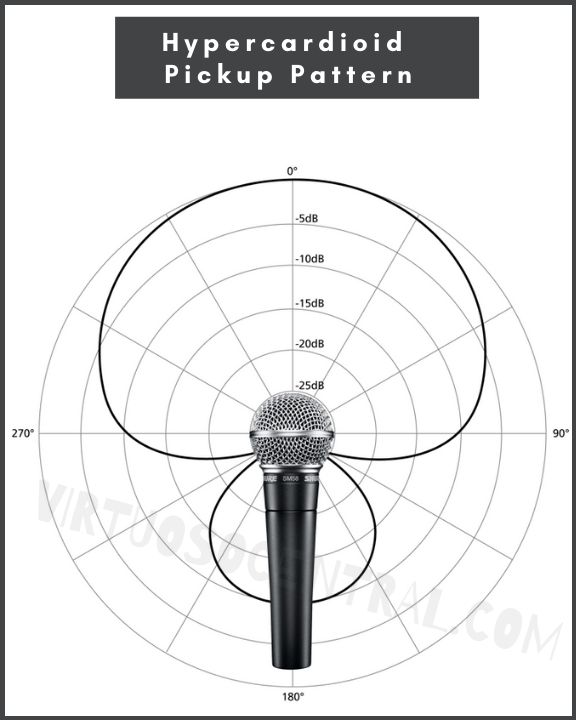
Bidirectional
This polar pattern I also known as figure 8, and basically it picks up the sound from both the front and the rear. It has a 90-degree coverage angle and 33% ambient sound sensitivity.
This pattern is not recommended for live condenser vocal microphones, they are mostly found in ribbon mics, and large-diaphragm studio mics used for specific purposes.
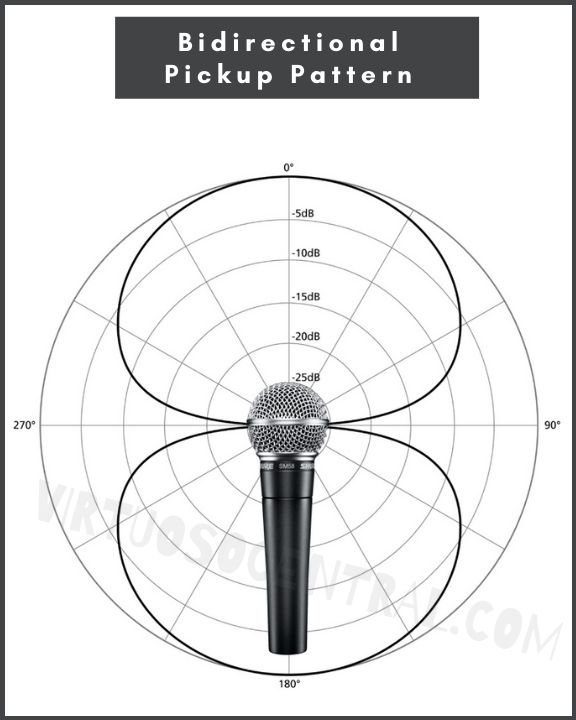
Shotgun
Also known as lobar polar pattern this would be the narrower of all making it the most highly directional mic rejecting sounds from other directions.
This type of microphone is mostly used in tv recording, film sets. Definitely not intended to be used for live vocal purposes.
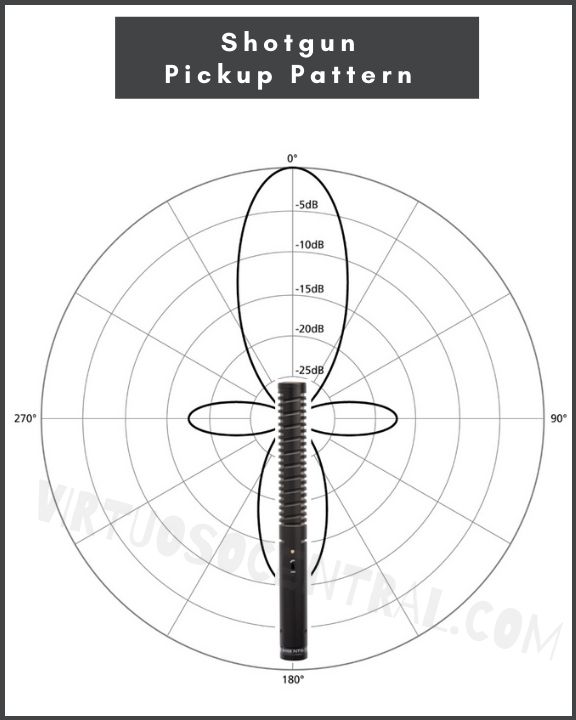
In summary, when choosing a live condenser vocal mic, you want to select one that is either cardioid, super-cardioid, or hyper-cardioid. But the most recommended for live condenser mics are super-cardioid and hyper-cardioid, these polar patterns perform well in live stages.
Frequency Response and Response Curve.
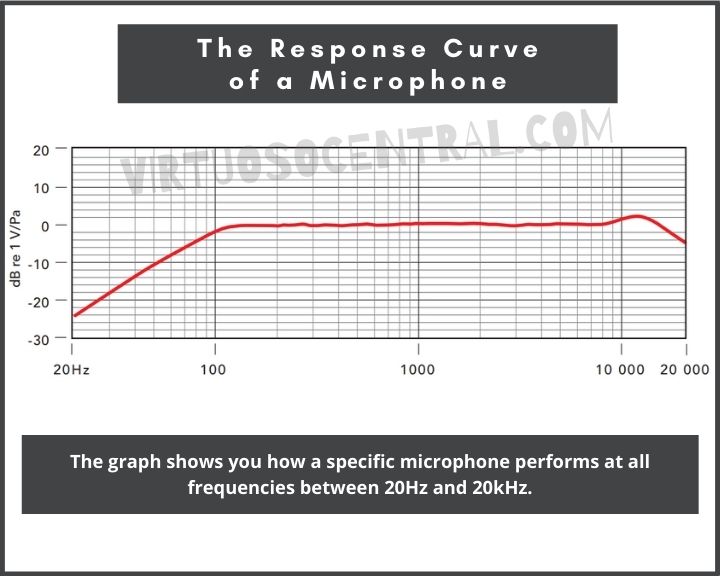
When selecting a microphone, it is important to know its frequency response. Most modern microphones have a frequency response between 20HZ and 20kHz. But this information is not enough because this only tells one side of the story.
We need to know how a microphone performs over the full frequency range. This is where the response curve comes in. The graph shows you how a specific microphone performs at all frequencies between 20Hz and 20kHz.
A microphone’s frequency response measures the intensity of sound at each frequency and it is measured in dB (decibels). It starts at 0dB on the lowest frequencies (less than 20Hz) and drops back to 0dB at the highest frequencies (above 20kHz).
It should be noted in the response curve that depending on where the peaks or higher intensity of sound are throughout the frequency response is what gives a certain sound characteristic to a mic and what makes a microphone suitable for a specific purpose
For example, a mic intended for vocals should have a relatively smooth response in the mid frequencies with a subtle spike in the upper midrange frequencies resulting in smoother reproduction of voices.
Maximum Sound Pressure Level or SPL.
The maximum sound pressure level or Max SPL for short is the maximum volume a mic can withstand without starting to distort the sound. It is measured in dB (decibels).
Most modern condenser or dynamic microphones range between 100dB – 150dB. When choosing the best live condenser vocal mic make sure that it falls between that range.
Frequently Asked Questions About Condenser Microphones
Can you use a condenser mic for live vocals?
Yes, condenser microphones can be used for live vocals. They are actually a good choice if you want detailed and clear sound from your vocals.
For experienced singers and vocalist, condenser mics are a popular choice but keep in mind that because they provide clearer sound this type of microphones are less forgiven with inexperienced vocalists.
Are condenser mics good for live performance?
Yes, condenser mics are good for live performance because they can capture clearer, detailed, and fuller sound. This type of mic is often used in live performances for vocals because they can capture the finest details in performances.
What type of microphone is best for live vocals?
For live vocals there is no such thing as the best one, as the idea of one size fits all. It all comes down to the sound tone you want, the environment where you are performing and mic that better captures your voice.
If you want clear high definition sound a condenser could be the right one for you. If you want a vintage sound, a ribbon mic would give you that result. If you want a microphone that reproduces transients less accurately then a dynamic would be the best choice.
Are condenser mics better than dynamic?
Not necessarily. Condensers and dynamic microphones are two different types of microphones. Each one has unique sonic characteristics. It all comes down to the kind of sound you are looking for.
If you want a crisp, clear sound and be able to pick up the finest details of the performance, then you should choose a condenser mic.
If you want a sound that delivers a clear upper midrange warm sound, then a dynamic microphone like the Shure SM58 should be your choice.
Is the SM58 a condenser mic?
No, the Shure SM58 is a dynamic microphone that provides good sound quality. They are also known to be very robust. It is one of the industry standards when it comes to live performance.
Does a condenser mic need phantom power?
Yes, all condenser mics need phantom power to work. Phantom power is +48VDC provided by the mixing console, mic preamp, or audio interface. This voltage is needed so that the internal circuitry in the mic can function.
What polar pattern is best for vocals?
The best polar pattern for vocals is cardioid and it is also the most popular. But keep in mind that a polar pattern should be chosen depending on the environment where you are performing and on the results you want.
For example, if you are singing in a live stage where there are many instruments, speaker monitors and other vocalists, the best choice would be a super-cardioid or hyper-cardioid. The reason is because these two patterns have a narrow pick up angle and more rejection to ambient sound which translates in less noise and less feedback.